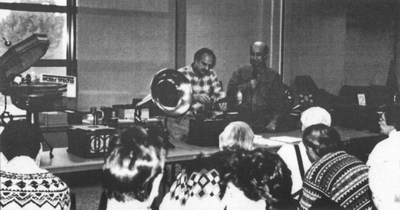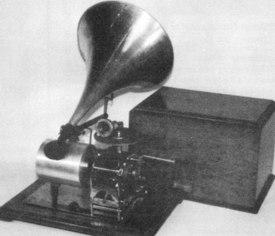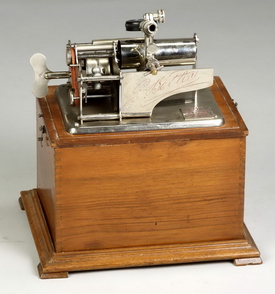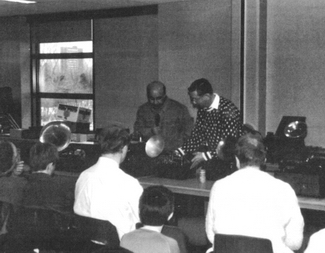|
Rare "Talking Machines" from the Collections of CAPS Members
by Mike Bryan
CAPS President Mike Bryan discusses the Bettini #8 Phonograph while CAPS member
Domenic DiBernardo demonstrates this very rare machine

|
|
Edison Spring Motor Phonograph ca 1895 (Owner: Bill Tarling)
Edison received his patent on the Tinfoil
Phonograph in 1878, but his attention was soon
turned to the production of electricity and the
development of electric light. It was only after Bell and
Tainter came up with the wax cylinder, instead of tin foil
strips, as a superior medium for recording, that Edison
eventually renewed efforts to develop his invention. He
was not immediately successful, but after a 72 hour crash
development program in June 1888 he emerged from his
laboratory into the daylight with his "perfected"
Phonograph, a battery driven machine.
Battery power turned out to be less than satisfactory and
over the next few years Edison dabbled with man powered, water powered and treadle powered machines.
Since musical boxes had always been powered by clockwork motors and Edison's patent #1644 of 1878 included
a spring motor in its specification, it is somewhat surprising that it took 16 years before the spring motor appeared
in production models. In fact the Chicago Talking
Machine Co. was the first to mount the top works of
Edison’s electric machines to a new base with a spring
motor. The immediate success of this approach caught
Edison’s attention and in 1895 he launched his first production model known as the Edison Spring Motor
Phonograph with a 3 spring motor. The machine on display was a fine example of the earliest of Edison's spring
motor driven cylinder phonographs which appeared in may
more familiar styles right through to 1929.
This model remained in production until 1901 when the
case was changed to "New Style" and the machine renamed
"Triumph".
Zonophone A

|
|
Zonophone A 1899-1901 (Owner: Domenic DiBernardo)
The Universal Talking Machine Company was founded
in 1898 by Frank Seaman, a former colleague of
Emile Berliner. Seaman recognized the potential of
the lateral-cut disc and began making a range of machines
and records under the Zonophone name. He manufactured
these in New York and Berlin, producing machines in a
wide range of case styles. The Universal Talking Machine
Company had difficulty in competing with the industry
giants and in 1903 was bought out by Victor. From this
point Zonophone became Victor's low price line and the
gramophones began to adopt Victor features.
The first Zonophone
machines were the
models A, B, C and
D made between
1899 and 1901. The
machine on display
was a model A with
its 7" turntable and
two beveled glass
sides. Models A and
D are the rarest of all
Zonophones,
although no
machines from this
company could be
described as common.
However,
the
models introduced
from
1901
are more
often seen. From the
bottom to the top of
the range they are the
Home, Parlor, Grand, Concert, Grand Opera
and Concert Grand plus one later machine,
the Royal Grand, which was produced from
1906 to 1911
when Victor ceased production
of the Zonophone brand.
Dulcetto

|
|
Dulcetto 1901-2 (Owner: John Peel)
Between 1896 and
1910 at least 40 models were manufactured by
Columbia in the USA. At that time
Columbia was the only one of the Big Three
manufacturers supplying both disc and cylinder machines.
In England some distributors sold Columbia
machines under their own labels, one of
which was Dulcetto. Sometimes the Columbia
decal can be seen hiding behind the Dulcetto
name on the case, but it was not so on this
particular machine which was originally sold
by the Phono Exchange of 44 Berners Street
London. In fact, the most unusual top mechanism suggests that there may be no connection with Columbia at all. This phonograph
has a regular belt drive from the double
for the feed screw. We welcome enlightenment on this
spring motor, but there is a chain drive on top
machine and its origins from other members.
Ideal

|
|
Idéal Phonograph ca 1903 (Owner: Domenic DiBernardo)
The French phonograph industry got off the ground
in 1903 when Henry Lioret introduced his small
celluloid cylinders and doll phonographs. He went
on to produce some other interesting machines, but the
Pathé company soon dwarfed Lioret with its simple and
cheap mass market machines. However, as the market
expanded new phonograph companies jumped on the
bandwagon. An unlikely candidate was the French religious publishing firm of Maison de la Bonne Presse
which sold cylinder and disc machines under the name Ideal.
This most unusual machine plays both discs and cylinders
- both at the same time if you wish! Although this
might have been perceived as clever and innovative, the
idea did not take hold with the mainstream phonograph
manufacturers, who at different times wanted to narrow
the consumer's choice of record format to the one they
were selling. Another notable feature of the Ideal Phonograph is the
speed regulator.
Bettini #8 Phonograph 1902-08 (Owner: Domenic DiBernardo)
Bettini was a military
Italian who married an
American and moved to New York. Unimpressed
by the sound quality of Edison's phonograph,
which in 1888 was designed mainly for dictation, Bettini
set out to make a better reproducer. The following year
he introduced his patented "Micro Reproducer", which
was a large floating reproducer equipped with a spider.
Today these can still be found occasionally as attachments on the main brands of cylinder machines.
Bettini #8

|
|
Bettini's motivation had been to improve the quality of
reproduction so that recorded music could be enjoyed.
Having created the means to do this, he then went into
the recording business, but never produced significant
volumes of cylinders. In 1902 he moved to Paris where
he spent the next 6 years designing and producing cylinder and disc machines. Sales of Bettini's quality
machines were low, hence their rarity today. The nickel
plated #8 machine on display provided a rare opportunity
to see a product of the Bettini Micro-Phonograph Company.
Holzweissig Hymnophon
When we think of German machines
we often think of the Puck in its
various forms. However, when it
comes to disc machines, Germany produced
all sorts of styles ranging from lighthouses
and windmills to potted plants, barrels and
Greek temples - all cases housing and dis-
guising disc gramophones.
Less extreme, and in less dubious taste than
its beer barrel gramophone, was
Holzweissig’s Hymnophon, first produced as
early as 1904. Unlike the inside horn
machines of American manufacture, the
Hymnophon's horn is not concealed, but
merely set tastefully into the front of the
machine.
Maestrophone ca 1906 (Owner: John Peel)
At last year’s presentation we looked at a machine
thought to be a Maestrophone. When we found
that the motor was made in England, we began
to doubt this. Later we received a suggestion from
Australia that it may have been a machine
assembled in India.
Maestrophone

|
|
Anyway, this time we have a machine that
can more easily be identified as a
Maestrophone, which was the brand name
that the Swiss company Paillard gave to its
range of gramophones. Paillard had been a
successful cylinder music box maker during
the 19th century, but by the early 1900s the
talking machine had just about killed off the
music box industry.
Paillard recognized the need to change and by
1906 its catalogue showed no less than 76
disc gramophones. Many were in a similar
style to the machine on display, but there
were also a few inside horn machines.
Against this background it is interesting to
find a unique feature attributed to a few
Paillard models - a patented hot air motor,
which operated on a half pint of spirit for 45
hours of use.
The model shown is the polished walnut
Maestrophone Model #3 Tannhauser. It has a
2 spring motor which can play up to 3 10"
discs.
Capitol Model O Lamp Phonograph 1919-23 (Owner: Walter Hoffman)
After the First World War several companies
were inspired to produce disc machines
hidden in large table lamps.
There was the Fairy Phonograph Lamp made by
the Endless-Graph Co. of Chicago, the Phonolamp,
the Lampagraph, the Modernola (a floor model)
and the Capitol Model O presented at our meeting.
This machine was made by the Burns-Pollock
Electrical Mfg. Co. of Indiana Harbor, Indiana. It
was available in a bronze, silver or gold finish and
with a 10" or 12" turntable. This machine on dis-
play is in bronze and is all original apart from the
lampshade and top finial.
There has been some suggestion that these lamps
became a feature in houses of ill repute. At first
sight, this particular lamp seems to have been
found in more innocent surroundings in the attic of
a drive shed where church-goers used to tie their
horses. However, its past is darkened somewhat
when we learn that it was given to the original
church pastor for performing the greatest number of
baptisms in a year. The word among other local pas-
tors was that he had only achieved this great number by
"double dipping", so to speak.
CAPS John Peel demonstrates his Dulcetto Cylinder Machine

|
|
In addition to the machines brought to the meeting,
photographs of two interesting machines belonging to
CAPS member, Richard Frison of Alberta, were also
presented.
Edison Standard A Suitcase Model ca 1898 (Owner: Richard Frison)
The two end clips of the cover indicate that this
was one of the earlier machines made before
1900. What makes this machine more unusual is
the Polyphone Attachment. The two reproducers track
each other in the same groove about half an inch apart.
It was claimed that the attachment increased volume
and roundness
of tone. Richard didn’t quite confirm
this, suggesting only that the attachment produced a
slightly louder sound.
Brunswick Parisian Portable (Owner: Richard Frison)
This must have been a sleek and ultra modern
machine at the time. In order to create such a flat
and easily portable gramophone, Brunswick had
to revert to the exterior horn principle
- but with one that
was made of cardboard and which folded flat into the lid
of the machine.
Apparently, it plays quite loudly, although
sound quality suffers somewhat at the the expense of versatility.
It was great to have a contribution from an "out-of-town"
member and I thank Richard and all other exhibitors for
their contribution to this presentation of machines that
most of us so rarely have the opportunity to see and hear.
Sources
- The Edison Cylinder Phonographs 1877-1929 by
George Frow
- The Compleat Talking Machine by Eric Reiss
>LI>Talking Machines by VK Chew
- The Illustrated History of the Phonograph by Daniel
Marty
- The Talking Machine. An Illustrated Compendium
1877- 1929 by Fabrizio and Paul
- Maestrophone catalogue
- Vitaphone brochure
- Roll Back the Years by Edward Moogk
|